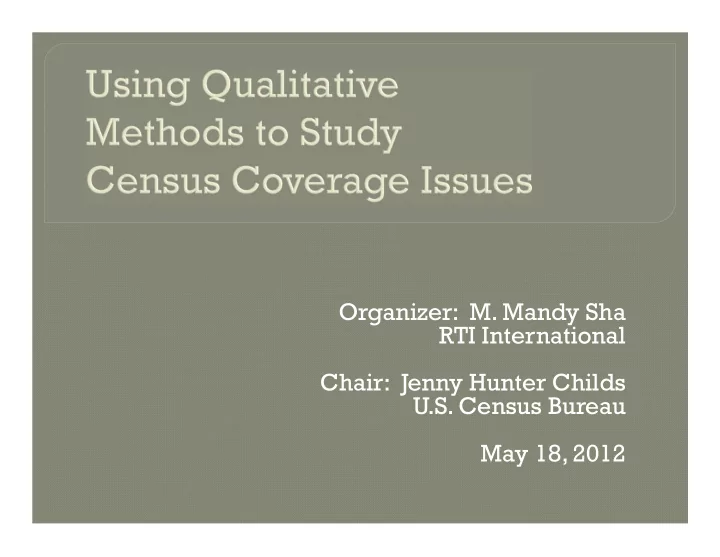

Organizer: M. Mandy Sha RTI International Chair: Jenny Hunter Childs U.S. Census Bureau May 18, 2012
Characteristics of People Overcounted in the Census Sarah Heimel Decennial Statistical Studies Division U.S. Census Bureau May 18, 2012
Goals of this Paper • Introduce the concept of duplication • Describe a few characteristics of duplicates in the 2010 census 3
Common Living Situations Causing Duplication in the Census • College Housing • Joint Custody Arrangements • Moving Around Census Day • Vacation / Seasonal Home • Stay with Relatives or Friends 4
Census Residence Rule & Residence Situations • Count people at the place where they live and sleep most of the time. • Examples on front of each Census form. • Respondents sometimes have a different idea than the census does of who to count at their address. 5
Identifying Duplicates in the Data • The data for each person listed on a census questionnaire was captured and compiled. • Computer algorithms reviewed every pair of persons in the census and compared name, age, sex and other variables to identify persons who might be duplicates. • The algorithm assigned a score to every pair; the score described the strength of the match between the two person records. • Two records that were matched with each other are ‘links’. • Only links with high scores (above a clerically determined cutoff point) were considered duplicates for this study and so were eligible for follow-up research. 6
Classifying Duplicate Links • Geographic Distance (Hierarchical) – Within Block – Within Surrounding Blocks – Within County – Within State – Across State • Housing Types – Housing Unit to Housing Unit (HU-HU links) – Housing Unit to Group Quarters (HU-GQ links) • No GQ to GQ links were identified 7
Implications from the Geographic Distance of Duplicates • Within Block and Surrounding Block Links – Primarily Attributed to Housing Level (Address) Issues • For example (but not limited to): – Duplicate (but slightly different) Addresses on the MAF • Within County, Within State, Across State Links – Attributed to Person Level (Living Situation) Issues • For example (but not limited to): – Joint Custody Arrangements – College Housing – Moving Around Census Day 8
Limitations of this Research • Incomplete universe to identify duplicates – Some census questionnaires were excluded from this matching • Not the final census universe – Questionnaires might not have actually been included in the final count • Large clusters not researched – One person could be identified on three or more census questionnaires. 9
Who are the Duplicates? • How many links were identified in this computer matching? Response Level Person Level Type of Link Number Percent Number Percent Housing Unit to Housing Unit 3,857,604 81.9 6,600,215 88.5 (HU-HU) Housing Unit to 853,956 18.1 853,956 11.5 Group Quarters (HU-GQ) TOTAL 4,711,560 100.0 7,454,171 100.0 10
Geographic Proximity • How close were the two addresses to each other? Response Level Person Level Geography of Link Number Percent Number Percent Within the same block 1,200,553 25.5 2,495,776 33.5 Within surrounding 373,167 7.9 786,273 10.5 blocks Within the same county 1,480,767 31.4 2,085,442 28.0 Within the same state 1,061,878 22.5 1,304,804 17.5 Across state lines 595,195 12.6 781,876 10.5 TOTAL 4,711,560 100.0 7,454,171 100.0 11
Geographic Proximity • How close were the two housing units to each other, by type, at the response level? HU-HU HU-GQ Geography of Link Number Percent Number Percent Within the same block 1,106,807 28.7 93,746 11.0 Within surrounding 360,526 9.3 12,641 1.5 blocks Within the same county 1,236,974 32.1 243,793 28.5 Within the same state 699,928 18.1 361,950 42.4 Across state lines 453,369 11.8 141,826 16.6 TOTAL 3,857,604 100.0 853,956 100.0 12
Phone Match • For the 3,857,604 HU-HU response links, how often did the two questionnaires report the same phone number? Phone Comparison Percent Exact same non-blank telephone number 24.6 Different non-blank telephone numbers 53.8 One blank phone number and one nonblank number 19.0 Both phone numbers blank 2.6 TOTAL 100.0 13
Type of GQs in Links • What types of GQs were duplicates counted in? Type of GQ in the Link Percent (n=853,956) 51.7 College/University Student Housing 17.5 Nursing Facilities/Skilled-Nursing Facilities 12.2 Correctional Facilities for Adults 4.7 Soup Kitchens, Transitional Shelters, Mobile Food Vans 4.3 Other Non-institutional Facilities 2.5 Group Homes and Residential Treatment Centers Intended for Adults 2.1 Military Quarters 2.1 Juvenile Facilities 1.6 Unknown Group Quarters Type Other Institutional Facilities 1.4 TOTAL 100.0 14
Overcount Question 15
Overcount by Geography • What percent of duplicates positively marked the overcount question (on at least one side)? Percent with An Overcount Mark HUGQ HUHU (N=853,956) (N=6,600,215) Within Block 13.9 15.9 Surrounding Block 26.4 19.1 Within County 39.5 55.7 Within State 76.1 72.4 Across State 80.1 75.9 TOTAL 58.7 41.3 16
Demographics • Demographics were compared across the two sides. • Each side of a link could have provided different information on the duplicated person. One side might also have provided information while the other side did not. 17
Age Age Percent Percent Age Category Percent Percent Category of Dups of US of Dups of US (N=7,454,171) (N=308,745,538) 50-54 5.4 7.2 Under 5 6.0 6.5 55-59 5.1 6.4 5-9 7.1 6.6 60-64 4.8 5.4 10-14 7.8 6.7 65-69 3.8 4.0 15-19 11.5 7.1 70-74 2.9 3.0 20-24 11.8 7.0 75-79 2.3 2.4 25-29 6.2 6.8 80+ years 4.3 3.6 30-34 4.7 6.5 Inconsistent 2.3 -- 35-39 4.4 6.5 Missing 0.2 -- 40-44 4.5 6.8 TOTAL 100.0 100.0 45-49 5.1 7.4 18
Conclusions • Duplication is an issue in the census. • There are some things the Census Bureau can do to minimize duplication from occurring before enumeration begins. • After the enumeration, telephone number comparison is a useful way to identify a sizable amount of duplication. • The overcount question could be utilized in the future to better identify and resolve duplication. • Youth, especially college-aged persons, have high rates of duplication. 19
Thank You! Sarah.K.Heimel@census.gov 20
Recommend
More recommend